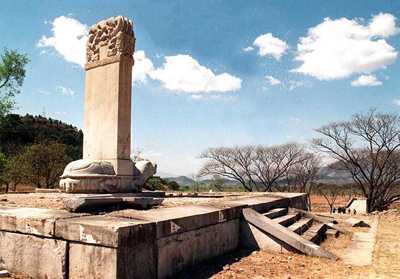| Travel in China > Protected Sites > Class Άρ > Tombs |
|
|
Ming Tombs
The Ming Dynasty was founded in 1368, after Emperor Taizu (Zhu Yuanzhang) overthrew the Yuan Dynasty (1271-1368). In the 17th year (1644) of the Chongzhen reign, the Ming Dynasty was overthrown by the peasant uprising led by Li Zhicheng. The Ming Dynasty lasted for 277 years with altogether 16 emperors. Emperor Taizu had reigned for 31 years, and after his death he was buried at the foot of Zhongshan Mountain in Nanjing. The second emperor was Emperor Jianwen named Zhu Yunwen, who stayed for 4 years on the throne. The king Yan named Zhu Di dispatched troops to the south, and attacked Nanjing. Nanjing was caught on fire, and nobody knew where Emperor Jianwen went. Someone said he burnt himself, and others said he became a monk. It is still an unsettled case in the history of the Ming Dynasty; Emperor Jingtai (Zhu Qiyu) was murdered during the Yingzong restoration of the dethroned monarch. At first, he was buried in Jinshan Mountain in the west suburb of Beijing, and his tomb was later enlarged and moved into the mausoleum called The Mausoleum of Emperor Jingtai. The other 13 emperors were all buried here, and the tombs of them are given one unified name Ming Tombs. The mausoleums take up over 40 square kilometers, with the Chaozong River winding eastward around it and the Dragon and Tiger Mountain confronting each other. The scenery is beautiful and grand.
The Changling Mausoleum for the 3rd emperor Zhu Di in the Ming Dynasty is in the center of the Ming Tombs, to the east of which are the Jingling, the Yongling and the Deling mausoleums, and to the west are 6 mausoleums including the Xianling, the Qingling, the Yuling, the Tailing, the Kangling mausoleums. There are three mausoleums, namely the Dingling Mausoleum, the Zhaoling Mausoleum and the Daoling Mausoleum to the southwest. Each mausoleum has a sacred path, a memorial archway and stone statues. The whole layout of the mausoleum consists of two parts: the sacred path and the grave.
The stone memorial archway is the starting point of the sacred path, built in the 19th year (1540) of the Jiajing reign, and was built of white marbles. It has 5 bays, with 6 columns and 11 floors. It is 28.86 meters in width, and 14 meters in height. Patterns of beasts decorate the stones that support columns. The big palace gate, the stele pavilion and the dragon and phoenix gate in turn stand in the north of the archway. On the two sides of this group of constructions are huge stone carvings, including 24 stone beasts and 12 stone human figures, creating a kingly atmosphere for the sacred path. Except some difference in area and the complexity and simplicity of the construction, the layout and the system are generally the same. The plane of the mausoleum is rectangular, with the mausoleum gate, stele pavilions, the Ling'en Gate, the Soul Tower and the Treasure City along the central axis.
The Ming Tombs are famous for the Changling Mausoleum with grand ground constructions, and the Dingling Mausoleum with its underground palace unearthed. The diameter of the Treasure City in the Changling Mausoleum is 340 meters. On the top of the Dingling there is battlement taking the shape of a brick castle. Inside the city, there is a huge earthen heap, under which is the underground palace. The Ling'en Palace is the most spectacular, and it is located in the three-layer stone platform circled by white marble guardrails. The stone platform is about 3 meters in height; its area is 1,956 square meters. It has 9 bays in the front and 5 bays in depth with yellow tiles, red walls, and double eaves; and 32 spun gold nanmu columns, among which the largest one has a diameter of 1.17 meters, and 14.3 meters in height; the girder, mast, purling, and rafters are all built of nanmu.
The Dingling Mausoleum was the joint tomb of the 13th emperor Shenzong Zhu Yijun and his two empresses. In 1956, approved by Premier Zhou Enlai, it had been excavated and archaeologically studied, unveiling the enigma of the underground palace. The total area of the underground palace is 1,195 square meters. It consists of front, middle, rear, left and right palaces. The arch gate of each chamber is finely carved, and decorated with braveness. Among them, the rear palace is the tallest, with 30 meters in length, 9 meters in width and 9.5 meters in height, and its ground is paved with burnished flower speckle stones. The coffins of Emperor Shenzong and his two empresses are put in the center of the coffin bed together with a red painted wooden case full of funeral objects The rare cultural relics unearthed in the tomb including gold crown, phoenix coronet, and china and silk, which are rare and invaluable in the world, and now on display in the showroom of the Dingling Mausoleum. |
||||
All rights reserved. Reproduction of text for non-commercial purposes is permitted provided that both the source and author are acknowledged and a notifying email is sent to us. |
||||
 |
